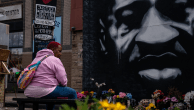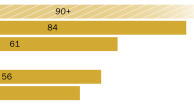Reporting Violent Crime3

Nearly eight-in-ten (78%) Hispanics state that if they were a victim of a violent crime, they would definitely report the incident to the police. The likelihood of reporting a violent crime incident differs by age, education and gender. Latinos ages 30 or older are more likely than Latinos ages 18 to 29 to say they would definitely report a violent crime incident to the police—84% versus 69%. Latinos with at least some college education (86%) are more likely to say they would definitely report a violent crime than are Latinos with a high school diploma (76%) or those with less than a high school diploma (77%). Women are more likely than men to say they definitely would report being a victim of a violent crime—82% versus 75%.
While most Latinos say that if they were a victim of a violent crime, they would report that incident to the police, a small share (5%) say they probably or definitely would not report the crime. Among those who say they would not report being a victim of a violent crime, nearly three-in-ten (29%) cite a fear of repercussions, such as immigration enforcement or discrimination, as a reason to not contact the police. Among immigrant Latinos who say they would not report a violent crime, 42% say they would fear repercussions if they reported the incident, compared with 18% of the native born. The second most common reason respondents cite for not reporting a violent crime incident is that they don’t expect the police to respond. More than one-quarter (26%) of Latinos who say they would not report being the victim of a violent crime identify this reason. Among immigrants who say they would not report a violent crime, 30% cite a perceived lack of response from the police as the reason versus 22% among the native born.
Criminal Victimization
Personal crime victimization rates among Hispanics in 2006 (28.4 per 1,000 individuals) were higher than the rates for whites (23.9 per 1,000) and lower than the rates for blacks (32.9 per 1,000 individuals), according to the Bureau of Justice Statistics’ National Crime Victimization Survey (NCVS). While Hispanics were more likely than whites to state on the NCVS that they were a victim of a personal crime in 2006, they were less likely (41.6%) to say they reported the incident to the police than white (48.3%) or black (55.0%) victims. Victimization and police reporting rates for whites and blacks include the Hispanic portions of those populations.
Property crime victimization rates among Hispanic households were 211.7 incidents per 1,000 households in 2006, compared with 156.7 per 1,000 white households and 185.6 per 1,000 black households. As was the case with personal crime, the share of Hispanic (33.5%) property crime victims who say they reported incidents to the police was lower than that of white (37.7%) or black (38.8%) victims.
Personal crime victimizations include such crimes as rape, sexual assault, robbery, aggravated assault and simple assault. Property crime victimizations include household burglary, motor vehicle theft and property theft.
In 2006 there were 6.3 million personal crimes and 19 million property crimes in the United States, according to the NCVS. Overall, the national personal crime rate per 1,000 individuals ages 12 or older was 25.4, and the national property crime rate per 1,000 households was 160.5.The NCVS, an annual survey of more than 70,000 U.S. households, is the most comprehensive survey of criminal victimization available. Respondents are asked about all criminal incidents in that calendar year, including those not reported to the police, in which they were a victim.
Reporting Property Crime
When asked if they would report a burglary or property crime to the police if they were a victim of that crime, more than eight-in-ten (84%) Hispanics say they definitely would. A greater share of Latinos ages 30 and older, compared with Latinos ages 18 to 29, say they would definitely report a burglary or property crime—87% versus 79%. Latinos with at least some college education are more likely than those with less than a high school diploma to say they would report such a crime—93% versus 80%.
Among the small share (4%) of Latinos who say they would not report a burglary or property crime, more than half (52%) cite a perceived lack of response from the police as the reason for not reporting the incident. The second most common reason for not reporting a burglary or property crime incident to the police is a fear of repercussions for reporting such a crime. More than two-in-ten (21%) Latinos who would not report being a victim of a burglary or property crime that reason.
Hate Crimes
According to the FBI, 7,624 bias-motivated crimes were reported in 2007 (FBI, 2007). Among these, 595 were directed against Hispanics, representing 8% of all bias-motivated crimes. In comparison, 2,658 bias-motivated crimes were reported against blacks and 749 against whites. Since 1990, the FBI, through its Uniform Crime Reports data collection, has compiled data on all reported crime incidents that had a bias motivation against a victim’s perceived race, religion, disability, sexual orientation or ethnic/national origin group.





